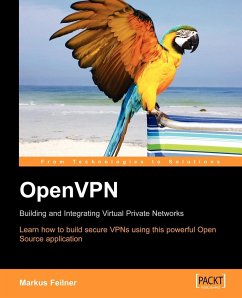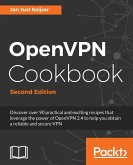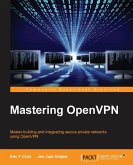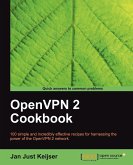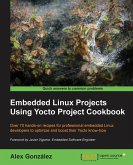OpenVPN is a powerful, open source SSL VPN application. It can secure site-to-site connections, WiFi and enterprise-scale remote connections. While being a full-featured VPN solution, OpenVPN is easy to use and does not suffer from the complexity that characterizes other IPSec VPN implementations. It uses the secure and stable TLS/SSL mechanisms for authentication and encryption. This book is an easy introduction to this popular VPN application. After introducing the basics of security and VPN, the book moves on to cover using OpenVPN, from installing it on various platforms, through configuring basic tunnels, to more advanced features, such as using the application with firewalls, routers, proxy servers, and OpenVPN scripting. While providing only necessary theoretical background, the book takes a practical approach, presenting plenty of examples. Network administrators and any one who is interested in building secure VPNs using OpenVPN will find the book valuable. It presumes basic knowledge of Linux, but no knowledge of VPNs is required. All basic VPN and relevant security concepts are covered. Chapter 1 looks at what VPNs are, how they evolved during the last decade, why it is necessary to modern enterprises, how typical VPNs work. The chapter also covers some essential networking concepts. Chapter 2 explains VPN security issues, including symmetric and asymmetric encryption, the SSL/TLS library, and SSL certificates. Chapter 3 introduces OpenVPN. In this chapter, we learn about the history of OpenVPN, how OpenVPN works, and how OpenVPN compares to IPSec VPN applications. Chapter 4 covers installing OpenVPN on both Windows, the Mac, Linux, and FreeBSD. It covers the installation on Linux from the source code and RPM packages. Installation on Suse and Debian is covered in detail. In Chapter 5, an encryption key for OpenVPN is created and it is then used to setup up our first OpenVPN Tunnel between two windows systems in the same network. The key is then copied on a Linux system and this system is connected through a tunnel to the first windows machine. Chapter 6 shows how to create x509 server and client certificates for use with OpenVPN. easy-rsa which comes with OpenVPN and is available for both Windows and Linux is used. Chapter 7 reviews the syntax of the command line tool openvpn, which enables building tunnels quickly. The configuration options of openvpn are covered in detail with examples. Chapter 8 shows how to make the example tunnels created earlier safer and persistent by choosing a reliable combination of configuration file parameters. It then covers how to configure firewalls on Linux and Windows to work with OpenVPN. Chapter 9 focuses on using xca, the advanced Windows tool with which x509 certificates can be easily managed. Its Linux equivalent, Tinyca2, which can even manage multiple certificate authorities, is also covered. Chapter 10 covers advanced OpenVPN configurations, including Tunneling through a proxy server, pushing routing commands to clients, pushing and setting the default route through a tunnel, Distributed compilation through VPN tunnels with distcc, and OpenVPN scripting. Chapter 11 shows how to debug and monitor VPN tunnels. It covers standard networking tools that can be used for scanning and testing the connectivity of a VPN server.
Hinweis: Dieser Artikel kann nur an eine deutsche Lieferadresse ausgeliefert werden.
Hinweis: Dieser Artikel kann nur an eine deutsche Lieferadresse ausgeliefert werden.

